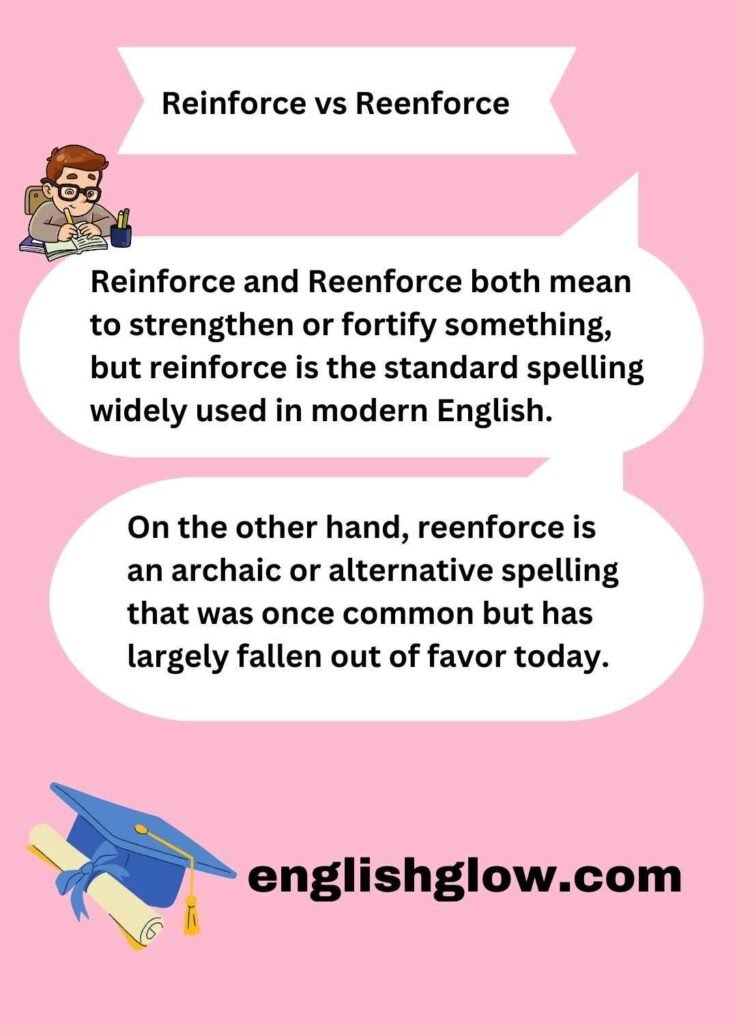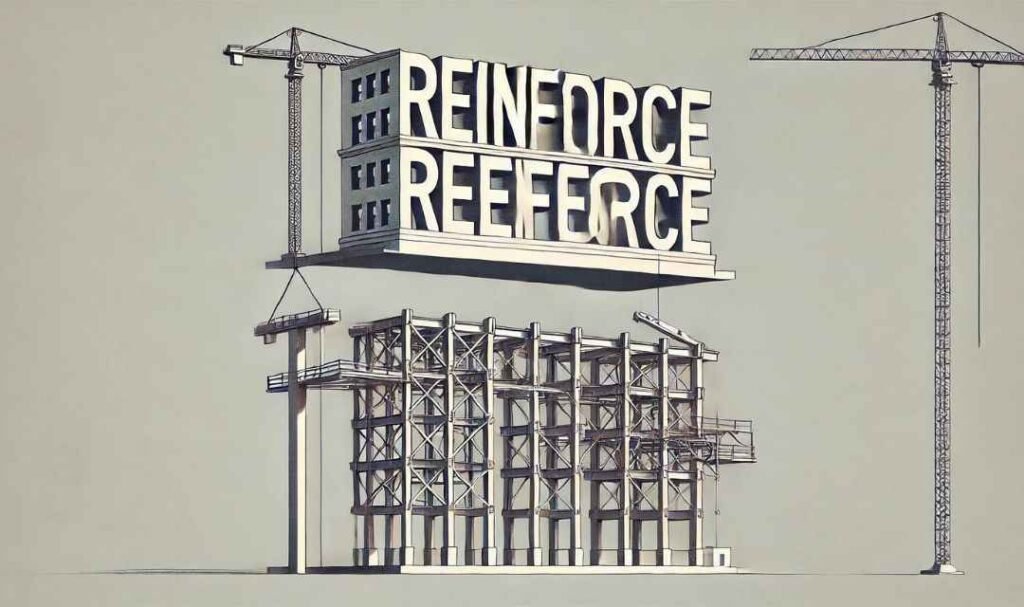“Reinforce” or “reenforce”? Let’s solve this spelling puzzle together!
These two words often confuse learners, but the difference is simpler than you think. “Reinforce” (✅) is the correct modern spelling meaning to strengthen or support. “Reenforce” (❌) is an outdated variant rarely used today.
Why the confusion?
-
History: Centuries ago, “reenforce” appeared in older texts (like “re-enforce” = enforce again).
-
Evolution: English simplified it → “reinforce” became standard by the 1800s.
Real-Life Examples
| Correct ✅ | Incorrect ❌ |
|---|---|
| “Extra practice reinforces grammar rules.” | ~~”Reenforce your knowledge.”~~ |
| “Builders reinforce walls with steel.” | ~~”Soldiers reenforce the border.”~~ |
| “Teachers use quizzes to reinforce learning.” | ~~”Parents should reenforce good habits.”~~ |
Memory Tip
Think of forts (strong buildings)!
Reinforce = RE-IN-FORCE → “Force strength in again”
Why this matters:
-
Using “reinforce” shows language accuracy in essays, emails, or tests.
-
Avoiding “reenforce” prevents distractions – like wearing mismatched socks to a job interview!
✨ Pro Insight: Even native speakers mix these up sometimes! When in doubt, always choose “reinforce”.
Definition of Reinforce Vs Reenforce:

“Reinforce” (✅) means to strengthen or add support to something. Think of it like adding extra pillars to a bridge!
| Situation | Example | Why It Works |
|---|---|---|
| Physical Support | “Builders reinforce walls with steel bars.” | Makes structures stronger |
| Learning/Memory | “Flashcards reinforce vocabulary.” | Practices until knowledge sticks |
| Encouragement | “Praise reinforces good behavior.” | Motivates through positive feedback |
“Reenforce” (❌) is not standard modern English. It’s an old spelling (like Shakespeare’s time 🎭) that’s now considered a spelling mistake.
You might enjoy reading: Maximal vs Maximum: Discover the Crucial Difference
which one is right—reinforce or Reenforce?
✅ “Reinforce” is always correct.
❌ “Reenforce” is outdated and considered a spelling error in modern English.
Why “Reinforce” Wins
| When to Use | Examples | Memory Tip |
|---|---|---|
| Strengthening objects | “Engineers reinforce bridges with steel beams.” | Picture “force inside (in-force)” → REINFORCE |
| Supporting ideas/habits | “Teachers reinforce grammar rules with quizzes.” 📝 | Think “add more force to make strong” |
| Encouraging people | “Praise reinforces students’ confidence.” | Link to “fortress” (both have ‘for’) |
Why Avoid “Reenforce”
-
Historical relic: Used in 1700s texts (like “colour” vs “color”) but extinct today
-
Spellcheck nightmare: Modern tools will red-line it as a mistake
-
Causes confusion: Readers may pause or question your language skills
Real-Life Impact
In an email:
Correct: “Let’s reinforce our marketing strategy.”
Incorrect: ~~”Let’s reenforce our marketing strategy.”~~
📚 In essays:
Using “reenforce” may cost you points for spelling accuracy.
Pro Tip: If you type “reenforce”, just swap the EE to EI!
Wrong: reenforce → Right: reinfEIrce ✅
Spelling of Reinforce and Reenforce

✅ “Reinforce” = Correct Modern Spelling
❌ “Reenforce” = Outdated/Obsolete
What “Reinforce” Means & When to Use It
| Context | Example | Why It Works |
|---|---|---|
| Construction | “Steel beams reinforce the bridge.” 🏗️ | Adds physical strength |
| Education | “Quizzes reinforce lesson concepts.” 📚 | Strengthens memory through practice |
| Sports | “Extra drills reinforce teamwork skills.” ⚽ | Builds reliable techniques |
| Psychology | “Praise reinforces positive behavior.” 💭 | Encourages repetition of good habits |
The Truth About “Reenforce”
-
Historical artifact: Used in 18th-century texts (like Shakespearean English 🎭)
-
Modern status: Considered a spelling error – avoid in emails, essays, and professional work
-
Spellcheck fate: Will be flagged as incorrect by all modern tools ⚠️
3-Second Spelling Guide
-
Remember: “I before E” → reinfIorce ✅
-
Fort Connection:
“A FORT needs REINFORCEMENT!”
(Both share ‘for’) -
Editing Hack: Replace “reenforce” with reinfEIrce
Real-Life Impact
Incorrect (Avoid!):
“Teachers should ~~reenforce~~ grammar rules.”
Correct:
“Teachers reinforce grammar rules through examples.”
Why spelling matters:
-
Professional writing: Errors reduce credibility
-
Exams: Costs points in IELTS/TOEFL essays
-
Clarity: Prevents reader confusion
Pro Tip: If you learned “reenforce,” just swap the ‘e’ and ‘i’ – now your English is reinforced!
Usage of Reinforce and Reenforce
-
When to Use “Reinforce”
Meaning: To strengthen or add support (like giving something a power boost! )
Context Example Why It Works Construction “Workers reinforce walls with steel bars.” Adds physical strength to buildings Education “Teachers reinforce lessons with fun games.” Makes learning stick through practice Behavior “Parents reinforce kindness with praise.” Encourages good habits with positive feedback Arguments “Use data to reinforce your opinion.” Makes ideas more convincing with evidence
Historical Usage of Reinforce and Reenforce:

-
(And why “reenforce” faded away)
14th Century Origins
-
Born from Latin re + inforcare (“to strengthen again”)
-
First Job: Military term for “sending extra troops”
“Reinforce the castle walls!”
Evolution Over Centuries
Era New Meanings Example 1700s Physical strengthening “Reinforce bridges with stone” 🏗️ 1900s Behavior/learning “Praise reinforces good habits” 📚 2000s Ideas/systems “Data reinforces the theory” 💡 Key Moments in History
-
1800s: “Reenforce” occasionally appeared in old texts (like “re-enforce the law”)
-
Early 1900s: Dictionaries declared “reinforce” the standard spelling
-
Today: “Reenforce” is a historical artifact – like using “thou” in modern speech
Reinforce vs. Reenforce: The Verdict
Reinforce Reenforce Status ✅ ONLY correct modern spelling ❌ Obsolete variant Used Today Everywhere: schools, construction, tech Only in historical documents Spellcheck Approved Flagged as error ⚠️ Why “Reinforce” Rules Modern English
-
Flexibility: Works for physical AND abstract strength:
“Steel beams reinforce buildings” (physical)
“Practice reinforces knowledge” (mental) -
Global Acceptance: Used in science, sports, psychology, and everyday life:
-
Sports: “Reinforce the defense strategy!”
-
Self-help: “Reinforce positive thoughts”
-
Did You Know?
Shakespeare might have written “reenforce,” just like he used “musick” instead of “music.” Language evolves!
-
Regional Differences of Reinforce and Reenforce:
-
🌍 “Reinforce” vs. “Reenforce”: Your Global Spelling Guide
✅ “Reinforce” is the only correct spelling worldwide – from New York to Sydney, London to Toronto. Whether you’re writing emails, exams, or social posts, this is the standard form recognized in all English-speaking regions.❌ “Reenforce” is obsolete everywhere – it’s:
Rare: Used in <0.004% of modern texts
Restricted: Only seen in 18th-century historical documents
Rejected: Flagged as an error by spellcheck tools globally
Regional Reality Check
Country Official Spelling Example
USA 🇺🇸 Reinforce “Engineers reinforce bridges.”
UK 🇬🇧 Reinforce “Teachers reinforce grammar rules.”
Canada 🇨🇦 Reinforce “Managers reinforce safety policies.”
Australia 🇦🇺 Reinforce “Coaches reinforce team strategies.”
No English-speaking region uses “reenforce” today – not in schools, workplaces, or daily life.Why Consistency Matters
Avoid confusion: Using “reenforce” is like writing “teh” instead of “the” – readers will notice!Professional impact: Resumes/emails with “reenforce” may seem careless
Exam safety: IELTS, TOEFL, and Cambridge tests deduct marks for this error
Real-Life Example:
A Canadian construction manual:
✅ Correct: “Reinforce concrete with rebar.”
❌ Incorrect: ~~”Reenforce concrete…”~~3 Universal Rules
Always use “reinforce” – no exceptions.Remember the fort:
“A FORT needs REINFORCEMENT!” (Both share ‘for’)
I before E:
reinfIorce ✅ ~~reinfEorce~~ ❌Pro Tip: If you see “reenforce” in an old book, read it as “reinforce” – that’s how we modernize historical texts!
Etymology of Reinforce and Reenforce:

-
Discover how this word evolved from ancient Latin to modern English!
Latin Origins (14th century):
*RE-* (again) + INFORCARE (strengthen) = “To strengthen again”
→ Like adding extra ropes to a ship’s mastJourney to English:
Era Form Meaning Old French Reforcier Fortify castles Middle English Reinforcen Support armies Modern English Reinforce Strengthen anything! How Meanings Expanded Over Time
Field Evolution Modern Example Construction Physical support → “Steel bars reinforce concrete.” Psychology (B.F. Skinner) Behavior shaping → “Praise reinforces good habits.” Education Memory boosting → “Quizzes reinforce lessons.” Business Team motivation → “Bonuses reinforce hard work.” What About “Reenforce”?
-
No real etymology: Just a 1700s spelling mistake
-
Like a language fossil: Found only in old texts, not living English
-
Modern status: ❌ Error in all dictionaries/tests
Why This History Matters
-
Word power: Knowing roots helps guess meanings (e.g., *re-* = again)
-
Spelling confidence: “Reinforce” has 500+ years of heritage!
-
Real-life usage:
“Managers reinforce training with feedback.”
“Bridges need reinforcing against storms.”
“Language is like a tree – ‘reinforce’ grew deep roots, while ‘reenforce’ was just a fallen leaf!”
-
Verb Forms of Reinforce and Reenforce
(Never “reenforce” – it’s always a spelling error!)
| Verb Form | Example | When to Use |
|---|---|---|
| Base Form (reinforce) |
“Engineers reinforce bridges.” | General actions & instructions |
| Present Participle (reinforcing) |
“The teacher is reinforcing the lesson.” | Ongoing actions right now |
| Past Tense (reinforced) |
“Yesterday, they reinforced the fence.” | Completed actions |
| Past Participle (reinforced) |
“The walls were reinforced last year.” | Passive voice / perfect tenses |
Why “Reenforce” Doesn’t Exist
-
No verb forms: You’ll never see “reenforcing” or “reenforced” in correct English
-
Spellcheck trap: Typing “reenforce” triggers errors in Word/Google Docs
-
Real-world impact:
❌ “The team ~~reenforced~~ their strategy.” → Unprofessional
✅ “The team reinforced their strategy.” → Clear and polished
Quick Grammar Tips
-
Future tense: Use “will reinforce”
“Builders will reinforce the roof tomorrow.” -
Present perfect: “have/has reinforced”
“She has reinforced this rule many times.” 💬 -
Negative form: “don’t reinforce”
“Don’t reinforce bad habits!”
Memory Trick:
Think of a fort being strengthened →
“RE-IN-FORCE” = REINFORCE ✅
(Both share “for“!)
Why this matters:
-
Using correct forms builds credibility in work emails and essays
-
Prevents confusion in IELTS/TOEFL exams
-
Makes your spoken English flow naturally
Noun Forms of Reinforce and Reenforce:
Reinforcement (re-in-FORCE-ment) is the valid noun from “reinforce”.
❌ Reenforcement doesn’t exist in modern English – it’s always a spelling error.
Real-Life Examples of Reinforcement
| Context | Example | What It Strengthens |
|---|---|---|
| Construction | “Steel reinforcement holds up bridges.” | Physical structures |
| Education | “Positive reinforcement helps students learn.” (e.g., stickers/stars) | Knowledge & confidence |
| Psychology | “Intermittent reinforcement makes habits stick.” | Behaviors |
| Daily Life | “Seatbelt alerts are safety reinforcements.” | Security habits |
Why “Reenforcement” is Wrong
-
No dictionary entry: Check Oxford, Cambridge, or Merriam-Webster
-
Spellcheck nightmare: Will be flagged as incorrect
-
Causes confusion: Like saying “teached” instead of “taught”
Memory Trick:
“FORCE needs REINFORCEMENT!”
(Both share “force“) → Reinforcement ✅
Why This Matters
-
Professional writing: Resumes/reports demand correct terms
-
Academic success: Essays marked down for “reenforcement”
-
Clear communication: Prevents misunderstandings:
“The bridge’s reinforcement (✅) saved lives.”
~~”The bridge’s reenforcement…”~~ (❌ distracts readers)
You might enjoy reading: How Does It Work or How It Works? Uncover the Key Difference Now!
Examples of “reinforce”

-
Real-Life Examples of “Reinforce”
See how this versatile verb works in everyday situations!
Learning & Behavior
Context Example Effect Education “Teachers reinforce grammar rules with quizzes.” ➔ Better retention Psychology “Therapists reinforce progress with small rewards.” ➔ Motivates positive change Parenting “Parents reinforce chores by offering screen time.” ➔ Encourages responsibility Work & Technology
Context Example Effect Construction “Engineers reinforce bridges with steel beams.” ➔ Prevents collapse Tech “Developers reinforce security with extra encryption.” ➔ Blocks hackers Marketing “Brands reinforce messaging through repeated ads.” ➔ Boosts brand recognition Relationships & Community
Context Example Effect Customer Service “Managers reinforce training with weekly role-plays.” ➔ Improves client satisfaction Relationships “Partners reinforce trust by sharing feelings openly.” ➔ Deepens connection Military “Commanders reinforce troops during critical missions.” ➔ Ensures mission success Safety & Critical Systems
Context Example Effect Healthcare “Hospitals reinforce hygiene with daily audits.” ➔ Prevents infections Architecture “Buildings reinforce foundations for earthquakes.” ➔ Saves lives Law Enforcement “New laws reinforce community safety protocols.” ➔ Reduces crime
What word can I use instead of reinforce?
-
Match the right word to your context:
Synonym Best For Example Strengthen Universal (objects/ideas) “Exercise strengthens muscles.” Boost Motivation/energy/numbers “Coffee boosts my focus.” Support Emotions/people/systems “Evidence supports the theory.” Fortify Physical structures/defenses “Walls fortified against storms.” Bolster Confidence/arguments/supplies “Data bolsters her proposal.” Enhance Quality/appearance/skills “Spices enhance the flavor.” Underline Emphasizing key points “She underlined the main rule.” Confirm Proving truth/validity “Facts confirm the discovery.” How to Choose
-
Physical objects? → Strengthen, Fortify
“Engineers strengthen (not ‘enhance’) bridges.”
-
Emotions/relationships? → Boost, Support
“Kind words boost (not ‘fortify’) morale.”
-
Academic/professional? → Bolster, Confirm, Underline
“Studies bolster the argument.”
Words to Avoid
-
Substantiate (too formal for daily use)
-
Reenforce (always incorrect spelling ❌)
-
What is reinforce in education?
Reinforcement means using rewards or consequences to encourage good learning habits. It’s like a GPS for behavior – guiding students toward success!
Positive Reinforcement (Adding Good Things)
Rewarding desired behavior to make it repeat:
-
Examples:
“Great question! Here’s a sticker for curiosity.”
“You finished early – choose a fun activity!” 🎲 -
Why it works: Builds confidence & makes learning joyful
Negative Reinforcement (Removing Bad Things)
Taking away something unpleasant when students improve:
-
Examples:
“No homework tonight since everyone aced the quiz!”
“Group chatter stops when assignments are done.” -
Key difference: NOT punishment! It releases pressure as a reward
-
Simple Ways to Apply This
Strategy How To Example Verbal Praise Be specific & immediate “Your essay intro hooked me!” Privilege Pass Reward with choices “Pick the next reading topic!” Progress Trackers Visualize small wins Sticker charts 📊 Task Removal Reduce workload for wins “Skip 2 review questions” Peer Recognition Let students celebrate each other “Clap for Maya’s solution!” 👏 The Golden Rule:
Reinforcement ≠ Bribes! Always connect rewards to effort/behavior, not just outcomes.
Conclusion:
✅ Remember: “Reinforce” is the only correct spelling today.
❌ “Reenforce” is a historical artifact – avoid it completely.
Why This Matters
-
Clarity: Using the right spelling prevents confusion (like writing “definately” instead of “definitely”)
-
Credibility: Shows professionalism in emails, essays, and presentations
-
Confidence: Mastering small details makes your English shine
Real-World Impact:
Email: “We’ll reinforce the security system” → Clear & trusted
Essay: “Studies reinforce the theory” → Academically strong
Your Action Plan
-
Always choose “reinforce” – in chats, work docs, and exams.
-
Remember:
“I before E” → reinfIorce ✅
“FORCE needs REINFORCEMENT!” (shared ‘for’) -
Proofread: Scan documents for “reenforce” → replace instantly!
“Language mastery isn’t about perfection—it’s about progress. Every time you use ‘reinforce’ correctly, you strengthen your skills and credibility!”
You might enjoy reading: Resetted or Reset? Discover the Best Option for You!

